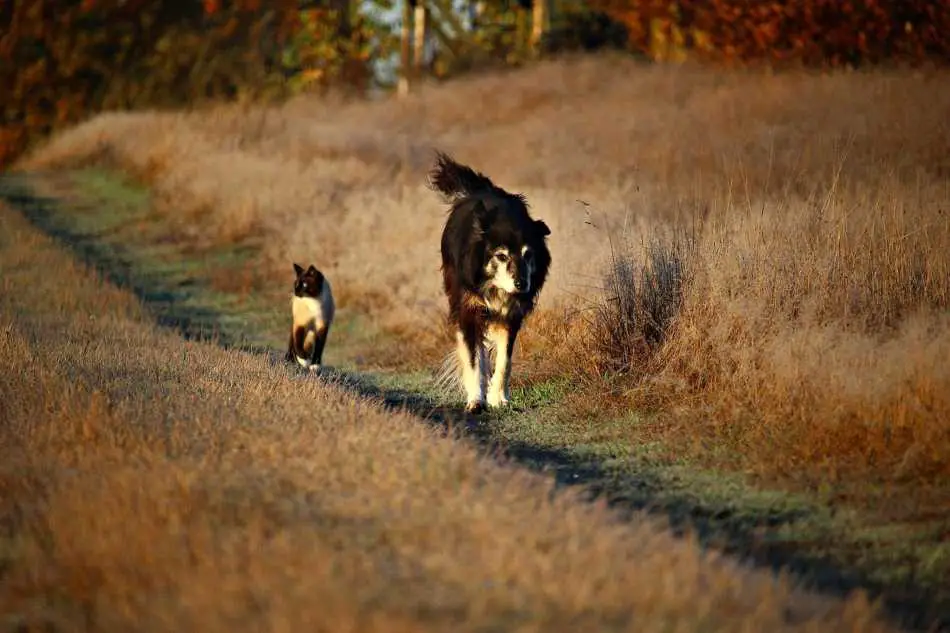 It happens to most dog owners at least once. You’re out for a walk when all of a sudden, your dog sits down. They might even lay down and refuse to move. Balking is a problem, but what can you do about it? Well, before you can solve the problem, you need to know what’s causing it. Sadly, some dogs are just super lazy, but most of the time, I’ve found that there’s something else going on when they act out on walks, and I can help you get to the heart of the issue.
It happens to most dog owners at least once. You’re out for a walk when all of a sudden, your dog sits down. They might even lay down and refuse to move. Balking is a problem, but what can you do about it? Well, before you can solve the problem, you need to know what’s causing it. Sadly, some dogs are just super lazy, but most of the time, I’ve found that there’s something else going on when they act out on walks, and I can help you get to the heart of the issue.
Why does my dog keep sitting down when walking? When your dog sits down suddenly while walking, they are in pain. Refusing to do what you ask is a form of doggy communication that you should always ‘listen to,’ when your pet is acting out. A dog who doesn’t walk could be hurting, though they often hide it surprisingly well.
Dog Health Problems While Walking
Numerous health issues could be causing your dog to sit down during walks. They can’t tell you what’s wrong, and a dog will often avoid limping or showing direct signs of pain. It’s not attitude when they do this but rather nature.
Dogs are pack animals, and their social hierarchy is dictated by strength, health, and dominance over the pack. A dog who is obviously hurting loses status for showing it. In nature, they might even be opening themselves up to an attack, so they hide the problem.
Be patient with your suddenly sitting pup. Your pet most likely isn’t trying to frustrate you, and they may need help. Especially if you have to carry a dog home, or if you see other signs of an issue, make a vet appointment right away.
Common Reasons Why a Dog Won’t Walk:
- Arthritis- This condition causes problems with joint inflammation and damage.
- Hip Dysplasia- HD is a genetic condition inherited from the parents, which also causes arthritis.
- Swollen Anal Glands- keeping an eye on the scent glands is a job that quite literally stinks, but it’s part of being a dog owner.
- Obesity- Any dog who weighs too much is putting extra stress on their legs, feet, and ankles.
- Injuries- Common, minor, and temporary injuries can cause your dog to decide not to walk suddenly.
- Memory/Fear- Your dog has an excellent memory, and when something scares or upsets them, they may have a flashback when walking past where it happened.
Arthritis
No animal wants to walk with their joints inflamed. Like humans, dogs are prone to arthritis. Although it’s more common in older dogs, it can happen quite unexpectedly. Arthritic pain comes from having an insufficient buffer between bones. They grind together, causing pain and sometimes swelling.
If every step your dog takes causes their bones to rub forcefully, then they aren’t going to want to go for walkies very long. Even a dog who always gets excited about going can change their mind when it hurts. Cold weather is the worst for arthritic dogs (and people). However, pain can happen at any time.
Your vet can help diagnose and treat doggy arthritis. Make sure your dog can stay warm since cold exacerbates the problem. Ask about putting your pooch on a high-quality supplement like GNC’s Ultra Mega Hip & Joint from Amazon. My dogs like the bacon flavor, but there are other options for pups with picky palates. Click here to find out more.
Hip Dysplasia
Hip Dysplasia is painful and might ruin your dog walking. You don’t have to have big dogs like mine to find this unfortunate issue. However, bigger dogs and those that grow too quickly are more prone.
When the ball and socket joint in a dog’s hip grinds together, it can hurt. More alarmingly, it can wear down over time. Though it’s similar to arthritis, they aren’t the same. Arthritis happens due to injury or imperfect bone formation and causes inflammation.
Hip dysplasia is inherited from the parents and is the result of one or both bones in the hip not fitting together correctly. Unfortunately, dogs with hip dysplasia will inevitably develop arthritis as well.
If you are raising a large breed puppy, you may want to consider feeding them a slightly lower protein diet while they grow to help keep them from sprouting up so fast it hurts their hips. Naturally, you should always discuss a big dietary decision like that with your vet. However, assuming you get approval, it can help prevent unnecessary damage from rapid growth.
Anal Glands
If your dog is sitting during walk time, the anal glands are one of the first things to check. These two small sacks on either side of your dog’s anus can get blocked off, infected, or otherwise irritated. Sadly, this is a common problem.
The most common display that should warn you there’s an anal sack issue is also one we often laugh off. A dog may scoot their butt across the floor to help relieve the pressure from glands that are enlarged. Dogs don’t do this to make you laugh or cringe.
Typically there’s a bad smell associated with this condition, but not always. Additionally, some people, like smokers, for example, don’t always notice the scent. New dog owners may not know what a healthy dog smells like and think it’s that ‘dog smell,’ they’ve heard about.
Watch out for excessive rear licking, signs of swelling, and dogs who strain to poop. These are all additional indications that anal glands may be hurting your dog.
Obesity
Obesity could be the culprit of your dog won’t walk. No one likes to admit they have an overweight pet. In fact, animal owners may not always be aware of what the correct, healthy body weight is for their dog. It varies significantly from breed to breed and changes over time with growth and aging.
Your dog is considered medically obese if they’re twenty percent or more above the healthy weight for their breed. When your pet is especially fluffy and long-haired, it might be less noticeable. Additionally, obesity doesn’t happen overnight and can creep up on you.
A dog who is carrying too much weight doesn’t enjoy their walks as much. Fortunately, you can do a lot to help them lose excess weight and maintain a healthy size. Talk to a pet care specialist about what your dog needs, and feed them a high-quality food without fillers and grains.
I suggest Blue Buffalo Life Protection Formula. It’s what I feed my dogs, and the brand is well known and trusted for its outstanding ingredients. When you feed your dog the right amount of better food, they stay healthy longer and can avoid problems like doggy obesity. Click here for prices and availability.
Injuries
Sometimes it’s not a severe or prolonged issue at all that’s causing your dog to refuse their walk. An injury could be to blame. A simple reason, like when they step on something sharp, is enough to stop them in their tracks. Be mindful of where your dog is and the things around you when you go out for your walks.
Like us, dogs can strain a muscle or sprain an ankle if they step wrong. Even a seemingly minor stumble could have consequences. Always stop and check to see if your dog is alright.
Similarly, when your dog has been sick, they may not feel up to all the exercise. Plus, in winter, they may be too cold, or in summer overheated. Keeping an eye on your dog’s wellbeing when your mind and heart aren’t really in the walk can be difficult, but it’s essential.
Doggy Memory
The past may be haunting a dog who sits down during a walk. Your dog remembers more than you might expect. If you went for a walk and something bothered them or scared them, then the memory might be making them hesitant.
Try switching up the route. If your dog will walk down one street but refuses a different path, then they’re holding on to a bad memory. It may not even have been evident at the time it happened. Instead of getting frustrated, be patient, and take a path without the unfortunate association.
Other Reasons Dogs Refuse to Walk
Your dog might be sitting down on walks to test your dominance. If you let them choose to be lazy, then you aren’t the leader. You lose your alpha status in the pack when you let a doggy dictate where and when you walk.
Take back control and gently make sure your dog knows when it’s time to get up. Try changing the pace if they have a favorite spot to stop. Jog past the area, or change direction unexpectedly.
Make sure your dog knows you are paying attention. Don’t get distracted on the phone or chatting with other people. Walk time should be about you and your dog. Bring treats to show them you appreciate their good behavior and compliance.
I prefer organic, healthy treats for my dogs. Instead of bringing meaty snacks, I make our walk treats special with Wet Noses Organic Dog Treats in peanut butter and banana flavor. Knowing there’s a special goody in it for them when they behave helps my dogs mind their manners when they’re on their leashes. You can pick up a box when you click here.
Final Thoughts
The specific cause for your dog taking a seat when they should be walking, the solution is the same. Pay attention. Your first responsibility as a pet parent is to keep them healthy, and you can’t do that if you have no clue what the problem is.
Take your dog to the vet if they act strangely. It’s in their doggy nature to hide it when they don’t feel well. A professional can check and see if your dog has an underlying condition or injury that is causing the trouble.
Keep in mind that all dogs get bored, tired, or frightened at times. When there’s nothing else wrong, change things up and take control of the situation in a positive way so you and your dog can get back to walking happily.
